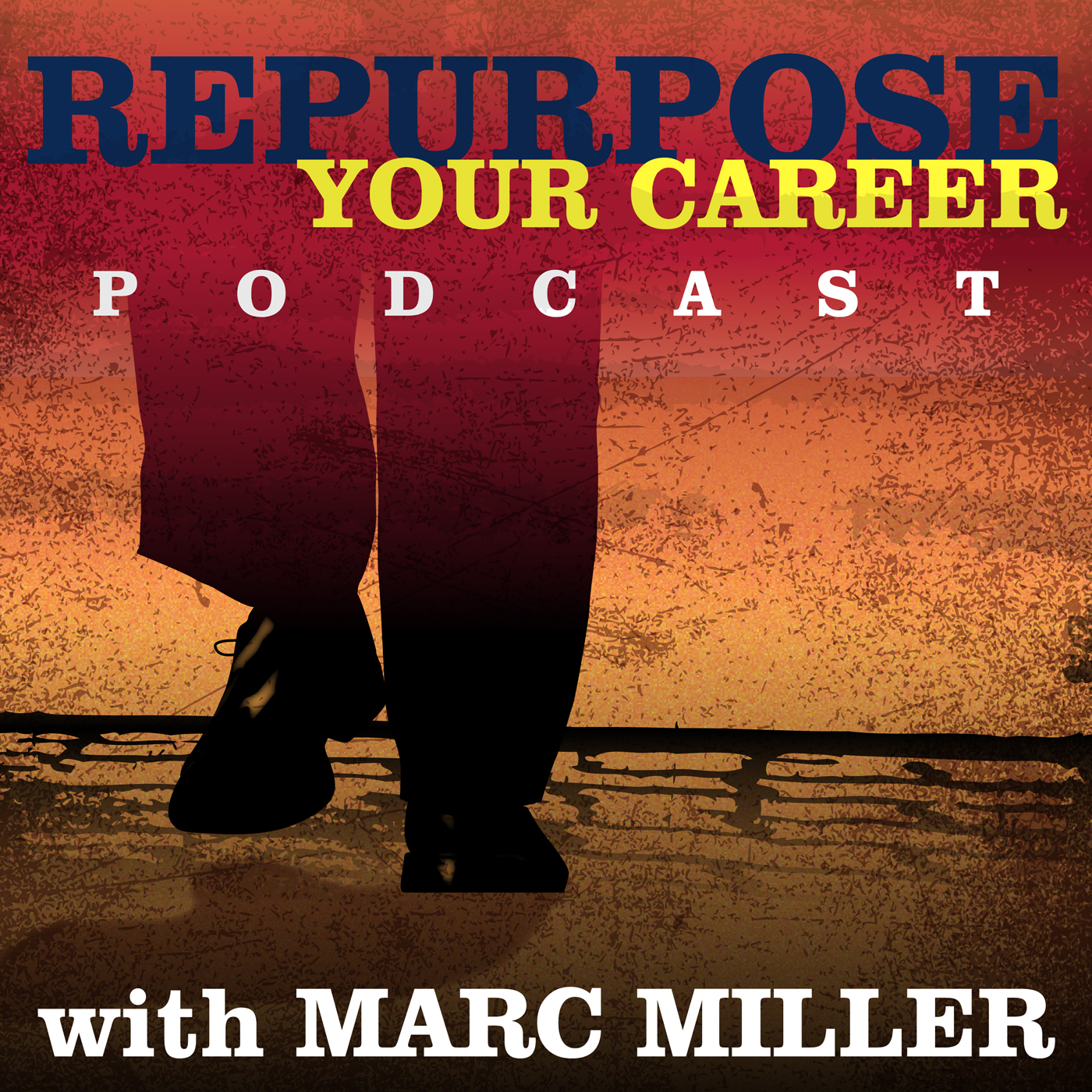Episode 50 – Marc works with Tim (not his real name) and takes him through the CareerPivot evaluation process, based on the Birkman Assessment.
Description:

In this episode, Marc shares Part 3 of 4 parts of the CareerPivot evaluation process. This is the Preferred Workstyles session, where Marc helps Tim understand his natural management style, corporate adaptability, work motivation, social adaptability, and responsibility. Tim learns his decision-making style and reviews his Lifestyle Grid.
Key Takeaways:
[2:02] Tim is a 50-year-old who has been stair-stepping himself out of a career and building a side business. Recently he got laid off, which was his trigger to complete his pivot. This episode covers Tim’s preferred workstyles: his natural management style, corporate adaptability, work motivation, and social adaptability and responsibility.
[2:43] Marc and Tim will discuss his decision-making style and his Lifestyle Grid.


Marc Miller
Can Tim Repurpose His Career? Part 3 of 4 #050
Download Link | iTunes | Stitcher Radio | Google Podcast | Podbean | TuneIn | Overcast
[2:50] If you haven’t listened to Episode 48 and Episode 49, Marc would suggest you stop here and listen to them, first. If you listen on the go, listen first without the reports and then download them from CareerPivot.com/Tim and listen to it again. There is a lot to digest, and Tim is very open about his experiences at work.
[3:26] Tim explains why he stayed at his last job so long. They gave him a new position with a new project every two or three years, which suited his need to create, and then move on. Marc calls him a multipotentialite, for having many interests. This is a poor fit for a specialist role that a corporation would want for a professional position.
[5:48] Tim puts his next steps on sticky notes, keeping them on a high level for the organization. When he gets ready to go into the details, he expands the notes. Tim has a broad spectrum of interests. He likes solving problems but is not process-driven. He only likes rules he develops, that he can break.
[6:53] Tim and Marc examine Tim’s preferred work style, as Marc explains the bars. The first bars are Tim’s Natural Management Style: Knowledge Specialist, Directive Management, or Delegated Management. Next are fitting into the Corporate Environment: Work Motivation, Self-Development, and Corporate Adaptability.
[7:43] The next two bars are Social Adaptability and Social Responsibility. These relate to fitting into society, and trust. On the right side of the page, the bars are in pairs that add to 11. These are Tim’s decision-making style. He is a linear, concrete thinker. Marc gives Tim an assignment to examine how he solved problems at work and at home.
[9:33] Marc expects Tim to be able to understand how he solves problems and to articulate the process to his manager. Marc’s method of assessment is to discuss the results with the client and then see how they apply in the client’s real life.
[10:02] Tim is 2 out of 10 a Knowledge Specialist and 9 out of 10 a Directive Manager, Tim is not a specialist, He leads from the front, directing the work. He takes charge.
[13:35] Tim should brand himself as an action problem-solving person, and choose clients who will let him be the guide. Tim shares an anecdote of a client relationship that works well for him.They let him lead their teams. Intuitively, he picked the right client.
[15:03] Marc asks Tim to survey that client, once they have a good relationship, and ask why they chose him. This will help him know whom he attracts. Tim tells another client story, where the client doesn’t quite get it yet. Tim’s broad and varied experiences help him connect to clients in various fields. He knows what they do.
[16:59] Tim is a 2 out of 10 in Delegative Management. Tim reads the description of his style. He would not want to be a VP because he would rather do the work than a Powerpoint report on work that someone else got to do.
[19:29] Tim does not like long meetings.
[19:42] Tim and Marc explore Corporate Styles, Work Motivation. Mark is a 6 out of 10. People with scores of 7 or above like work for work’s sake. People with lower scores tend to need a buy-in to get interested in the work. They need to see the value in their work. Marc explains that a 6 score needs some explanation, but not every detail.
[22:00] Tim is a 9 out of 10 on Corporate Adaptability. A score of 7 or above means they understand and are prepared to participate in corporate politics. They identify with the organization as an entity. Someone with a low score identifies with a manager or their coworkers, but not the company. The issue for high scorers is that it is very important to find an organization that has a corporate mission that resonates with you.
[26:39] Tim is aware of his own skills in playing office politics.
[27:16] Tim measures 10 out of 10 in self-development. That indicates he likes classroom learning, but he does not like to sit in a classroom. Onboarding needs to be a process he can follow with a roadmap.
[28:49] Tim is a 7 in Social Adaptability. That means he is a trusting person. He used to get dinged for that by bosses. Marc asks clients, whether they score low or high in this, to put in place a system where people can earn trust by keeping their agreements.
[31:07] Marc shares an anecdote of a project leader who ran things by intimidation.
[32:51] Tim’s Social Responsibility score is 8 out of 10. A score above 7 will go along with the corporate rules and procedures. In Tim’s case, he did so, but didn’t particularly like them. Personal Social Responsibility for Tim is not always following social rules, but seeing both sides of every story. In his own business, Tim will set the rules.
[36:34] Marc and Tim examine how Tim makes decisions. Public Contact is 9, Detail is 2. Tim’s score shows he wants to be around people, but not necessarily interacting with them. He could work at a coffee shop with wifi.
[40:07] Tim is 4 Global and 7 Linear. Global is relational and holistic. Linear follows a logical sequential process. Tim is more sequential than global. He shares an anecdote about interrupting the conversation with a whiteboard diagram, that gives a starting point.
[41:37] Tim is a 4 Conceptual and a 7 Concrete. Marc explains what this means for Tim. Marc happens to be a 10 Concrete. He just wants the data, not the backstory or fluff.
[44:53] On the Combinations of Problem-Solving page, Tim is a Concrete/Linear Thinker. This shows he is practical and action-oriented. They want people to give them the facts and get out of the way. Marc gives Tim an assignment around problem-solving.
[47:25] Tim’s Lifestyle Grid shows that his Red and Blue interests are very unusual. These are things that when he does, he gets energy. They are things he likes to do, They are solving practical problems, being directly involved, doing things/working with people, organizing tasks while focusing on the people who do them, getting things done.
[48:13] Marc notes that this matches clearly with Tim’s side business. These are things Tim needs in his day to be happy. He did not get them all at his last job.
[49:08] The Blue diamond shows Tim is Thoughtful, Reflective, Insightful, and Optimistic. Also, Competitive, Enthusiastic, and Assertive. The things Tim does are very operational. The way he behaves is more on the creative side. Tim is more motivated by the job than by the title or the management aspect of a role.
[51:45] The whole point of an assessment is to take the big data from Tim’s years of work experience and find out with it means about him, and the job that is right for him.
[52:06] We often go back to what is familiar because it is familiar. It doesn’t mean it’s good for us. Marc tells why that doesn’t work out well.
[53:31] The Blue circle shows how Tim wants to be treated. He is most comfortable when people around him show they appreciate him, are interested in feelings, as well as logic, give him time for complex decisions, give him time alone or with one or two others, and don’t overschedule him. He wants to be on a team of people that like him.
[54:37] Tim’s Stress Report will help him know what kind of client he wants to deal with. Tim’s Stress Behaviors are Withdrawing, Fatigued, Indecisive, Pessimistic, Overly sensitive to criticism. Marc gives Tim an assignment to place the list where he will see it frequently, and be able to head off these behaviors. Tim engages in negative self-talk.
[56:40] Marc recommends Positive Intelligence: Why Only 20% of Teams and Individuals Achieve Their True Potential AND HOW YOU CAN ACHIEVE YOURS, by Shirzad Chamine. It talks about the sage side of the brain, and the saboteur side. It has exercises to manage self-talk.
[58:36] Tim has a lot of self-talk, so he needs to stay around positive people. Marc gives Tim assignments that will lead to a narrative of who he is. The last assignment is to download Marc’s Career Reflection worksheet from the show notes.
[59:57] Marc gives Tim questions to answer for next week, about good experiences and why they were good. The next session will be on Tim’s Stress Report, and things he can do to stay out of stress, or to get out of stress if he is in it.
[1:02:08] Marc invites listeners to download the assessment for Tim from the CareerPivot website.
Mentioned in This Episode:
Please pick up a copy of Repurpose Your Career: A Practical Guide for the 2nd Half of Life, by Marc Miller and Susan Lahey. When you get done reading the book, please leave an honest review on Amazon. The audio version will be available in late October.
Watch for news of the membership community of the CareerPivot.com website. Marc has an initial cohort of members helping him develop the content. Soon Marc will start a wait list for those who want to participate.
Take a moment — go to iTunes, Stitcher, or Google Play. Please give this podcast a review and subscribe! If you’re not sure how to leave a review, please go to CareerPivot.com/review, and read the detailed instructions there.
Careerpivot.com
Contact Marc, and ask questions at Careerpivot.com/contact-me. Marc answers your questions every month.
Twitter: @CareerPivot
LinkedIn: Marc Miller
Facebook: Career Pivot
How to Find More About the Podcast and Subscribe
Make sure to check out the Career Pivot Community.
You can contact us here.
Marc invites you to connect with him on LinkedIn.com/in/mrmiller. Just include in the connection request that you listen to this podcast.
You can look for Career Pivot on Facebook, LinkedIn, or @CareerPivot on Twitter.
You can get updates on this podcast by clicking on the Get Career Pivot Insights button below.
You can also subscribe to the podcast on iTunes, Stitcher, Google Podcasts, Podbean, Overcast, Spotify, and Pandora.
The podcast is available on YouTube.
Please consider writing a review on Apple Podcast or on Podchaser.com.
Like What Your Read? Get Career Pivot Insights
Do You Need Help With ...
Check out our Help Center where you have access to 14 different content portals.

